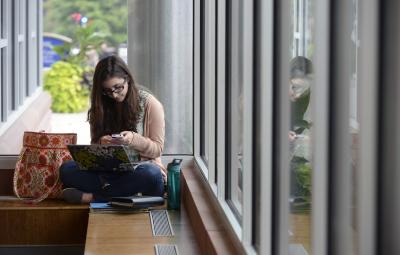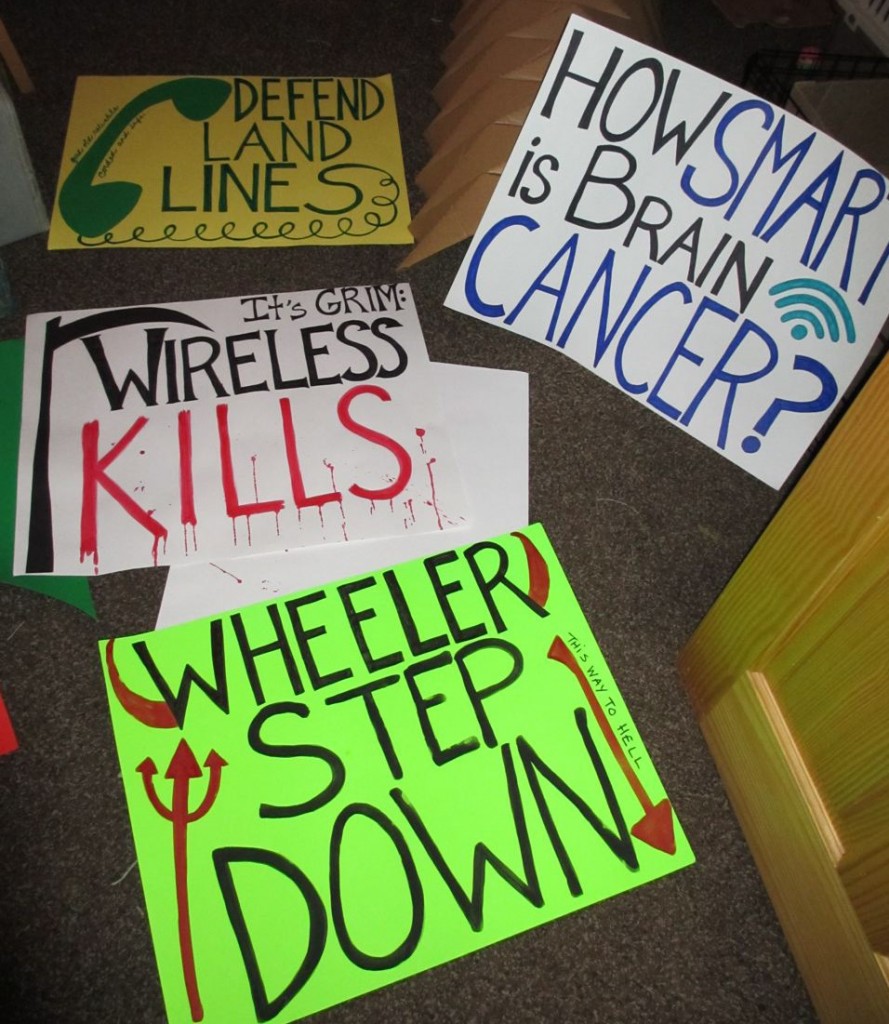Category: Public Health
Dr. David Carpenter talks about wireless cancer risks and what you can do to protect your family
Dr. David Carpenter is the co-author of the Bioinitiative Report and director of the Institute for Health and the Environment at the University of Albany. He talks about cell phones and brain cancer risk, children’s risk, high intensity pulses from smart meters, 60 HZ fields, radio towers, Obama supported wifi in schools and electrosensitivity.
He says, “the evidence is overwhelming” that cell phones increase your risk of brain cancer, and children are at 5 fold greater risk. He says, “Children are by far the most vulnerable.” Regarding wifi in schools, “everyone will be adversely affected.” The interview concludes with some solutions on what you can do to protect yourself and children. This video os no longer available.
Will it soon be too late? Cancer expected to increase by 70% in the next 20 years according to WHO
 Commentary by Dr. Olle Johansson, translated from Swedish:
Commentary by Dr. Olle Johansson, translated from Swedish:
DEBATE. The World Health Organization [WHO] has released a bleak future forecast. The number of new cancer cases is expected to increase from 14 million to 25 million per year over the next 20 years – an increase of 70 percent.
“Despite encouraging progress, the report shows that we can not treat ourselves out of the cancer problem,” said Christopher Wild, co- author of the report. But one question lingers for me: Why does WHO themselves not consider another possible cause of this avalanche, a cause that they themselves have warned about and predicted? Let me explain.
Today, various wireless devices flood our homes, schools and other workplaces. The issues around all of these sources of radiation are numerous. Adults are not at all certain that all this radiation is harmless, they are not at all sure that wireless technology is without risk. To this one can add numerous studies and investigations, expert reports and commentaries arise which in summary say that “there is a strong suspicion of damage.”
These texts also emphasize the need for the use of the Precautionary Principle and this even stronger after the WHO has classified radiofrequency electromagnetic fields – from mobile phones, tablets , etc. – as possibly carcinogenic (Class 2B). Thus, the idea that these techniques would be safe, we can immediately cross out – not even the WHO believes it – and they still have a category into which such proven safe exposures would fall (Class 4 – proven non-human carcinogen).
The question now is instead what we accept the risk to cost in terms of health care, disability and premature death.
It should be noted that this is an addition to the earlier (2001) WHO 2B cancer classification of power-frequency electromagnetic fields (thus including common household current ) – which are also emitted at high levels from handheld gadgets such as tablet devices (iPad etc.) and mobile phones – as a risk factor specifically for childhood leukemia. Given that in 2001 the WHO was already very close, voting 9 to 11, to move it to 2A (thus the higher cancer class ) and considering all the new knowledge that has accumulated since 2001, I maintain that today one should definitely classify the relationship between childhood leukemia and power-frequency electromagnetic fields in the much more serious 2A (“probably carcinogenic”) category.
Why not debate this?
There was a time when people did not understand that radioactivity from radium, uranium and plutonium, medical x-rays and ultraviolet light actually hurts us and can even kill us. You could see shoe-fitting x-ray machines in childrens’ shoe shops in Sweden as late as the end of the 1940s and elderly people will remember the glowing radioactive wristwatches that were popular in the 1950s. About the same time we began to understand that even the sun’s beautiful and warm rays can damage our cells and their genetic material with the development of skin cancer as a result. Today we warn everyone, even for the weakest of ultraviolet light, which we call UVA, especially if you’re a child with fair skin and light hair.
Against this background one might wonder: Can our cells and molecules that are now suddenly exposed to an environmental exposure from power-frequent magnetic fields, microwaves, radio and TV signals, etc. which have never before existed, or if it has, with an immediate increase of one million million million times stand it at all? The radiation goes right through us, and our – and other organisms’ – cells and molecules have no protection at all against it.
I’m afraid, very afraid, that we will soon have to write a new report titled “Too Late Lessons from Early Warnings” …
Olle Johansson is Associate Professor and Assistant Professor in Neuroscience at the Karolinska Institute, Stockholm. From the original in Swedish published 12 Feb. 2014 by Newsvoice.
Santa Clara County MD warns: Internet and Wi-Fi in schools can affect learning
Cindy Lee Russell, M.D., Vice President of Community Health, Santa Clara County Medical Association wrote an article warning about the health risks of technology in schools: Shallow Minds: How the Internet and Wi–Fi in Schools Can Affect Learning
Dr. Russell writes: “There are a host of concerns with classroom technology, and the virtual world it creates, that have not been explored in the rush to “modernize” education and prevent our kids from becoming “computer illiterate,” despite the fact that computers are designed for ease of use. These issues range from distraction in the classroom, impairment of cognitive development and long-term memory, deficiency in learning social skills, Internet addiction, cyber bullying, access to inappropriate content, eye fatigue,and security risks to online learning networks. In addition, the sheer cost of computers and continuous upgrades is likely to break many school budgets. We have not mentioned the issue of toxic e-waste, another growing public health problem.”
“We will not get rid of the Internet or computers. We should not ignore, however, the enlarging body of science that points to real threats to public health and, especially, our children’s safety and well-being. The best approach is precautionary. Reduce the risk by reducing the microwave emissions. It is our obligation as physicians and parents to protect our children. They are the future and our legacy.”
Dr. Russell recommends:
- Remove wireless devices (white boards and routers) in schools in favor of wired connections and fiberoptic.
- If there is Wi-Fi, then give teachers the authority to turn it off when not in use or if they feel it is not necessary.
- Ban cell towers near or on schools.
- Limit screen time on computers.
- Limit or ban cell phone use in the class
- Limit or ban cell phone use at home
- Do not allow laptops to be placed on laps
- Undertake independent scientific studies on Wi-Fi and computer use that look at acute and long-term health effects.
- Train teachers how to recognize symptoms of EMF reactions.
- Conduct meetings with parents and teachers to address this issue in each school.
Dr. Russel cites the science, international actions, and provides a reference list. This is an excellent paper to give to school principals and administrators.
Greet FCC’s Wheeler with a mass funeral protest for wireless safety
Join protests for wireless safety in SF bay area! Thurs. January 9!
Greet new FCC chair- wireless industry leader Thomas Wheeler with a mass funeral. People will be wearing black, carrying a coffin and reading the names of brain tumor victims.
Bring signs, friends, a trumpet, kids. Wear black! Protests held at two locations:
11:00 am in Mountain View at the Computer History Museum – 1401 N. Shoreline Blvd.
5:30 pm in Oakland at the Preservation Park Niles Hall at 1233 Preservation Park Way
Sponsored by: California Brain Tumor Association and Stop Smart Meters! Questions call 925-285-5437 or 360-201-3959 http://stopsmartmeters.org/2014/01/03/fcc/
Cell phones linked to anxiety, lower grades, and unhappiness
 Almost everywhere you look someone has a cell phone pressed to their ear, or has one in their hand. Students depend on the devices to connect with friends and family.
Almost everywhere you look someone has a cell phone pressed to their ear, or has one in their hand. Students depend on the devices to connect with friends and family.
A recent study led by Kent State University researchers, surveyed more than 500 undergraduate students from 82 different majors. They recorded daily cell phone use along with anxiety and happiness levels. In addition student grades were included in the study.
Results were students who used their cell phones more had lower grades, higher anxiety, and less happiness relative to their peers who used the cell phone less.
Earlier this year, Kent researchers linked cell phone use to poor student fitness. These results suggest that people should be encouraged to reduce their cell phone use! Or, better yet, use them for emergencies only!
Safety tips for cell and cordless phone use: Learn more
Dr. Mercola’s comments on this study include raising awareness about second hand radiation effects.
Dr. Mercola writes: “Respect Others Who Are More Sensitive: Some people who have become sensitive can feel the effects of others’ cell phones, iPads, and other gadgets in the same room, even when it is on but not being used. If you are in a meeting, on public transportation, in a courtroom or other public places, such as a doctor’s office, keep your cell phone turned off out of consideration for the “secondhand radiation” effects. Children are also more vulnerable, so please avoid using your cell phone near children.”
Can cell phones cause autism?
Most people do not know that cell phones and wireless devices can affect unborn children. A new study reports exposures from electromagnetic fields and wireless radiation may contribute to autism. Autism now affects about one in 88 children with a staggering cost estimated at $137 billion per year in the US.
In the 1970’s, before widespread use of cell phones autism was a comparatively rare health issue. Today, autism is so prevalent that the Centers for Disease Control call it a national health crisis.

 Co-authors Dr. Martha Herbert and Cindy Sage have integrated the results of over 550 scientific studies that report biological effects of electromagnetic radiation and wireless exposures, and of common biology and brain problems in autism.
Co-authors Dr. Martha Herbert and Cindy Sage have integrated the results of over 550 scientific studies that report biological effects of electromagnetic radiation and wireless exposures, and of common biology and brain problems in autism.
Many of the behavioral and biological characteristics seen in autism are similar or identical to those produced by typical daily exposures to cell and cordless phone radiation, cell towers, baby monitors, wireless tablets, WI-FI and other sources of pulsed electromagnetic radiation. But, personal choices can make a big difference in lowering exposure for pregnant women, infants and the whole family.
Dr. Martha Herbert, PhD, MD of Harvard Medical School and a pediatric neurologist with Massachusetts General Hospital says “such exposures can have a disorganizing effect on the brain’s ability to learn and remember, and can be destabilizing to immune and metabolic function”.
Children are more vulnerable than adults to environmental toxins, and can be affected in-utero as well as during the rapid growth of early childhood. Brain and nervous system in young children appear to be particularly sensitive.
The CHE EMF Working Group hosted a teleconference call with Cindy Sage and Dr. Herbert.
Students demonstrate wireless hazards at Science Faire
Two young scientists researched and studied wireless health risks for science fair projects. One student was interested in the controversy surrounding wi-fi and whether it should be in schools or not. She found fruit flies exposed to industrial wi-fi had genome mutations. Another student researched mobile phone radiation and warns about brain cancer, insomnia and other health problems.
In May of 2013 a team of Danish 9th grade girls did a science study on wi-fi and found watercress seeds would not grow near a wi-fi router.
The students placed six trays filled with water cress in a room without radiation, and six trays in another room next to two wi-fi routers. Over the next 12 days, the girls observed, measured, weighed and photographed their results. The cress seeds placed near the routers had not grown, whereas the cress seeds in the other room, away from the routers, thrived.
 The experiment earned the girls top honors in a regional science competition and the interest of scientists around the world. Full story here: Student Science Experiment Finds Plants won’t Grow near Wi-Fi Router
The experiment earned the girls top honors in a regional science competition and the interest of scientists around the world. Full story here: Student Science Experiment Finds Plants won’t Grow near Wi-Fi Router
